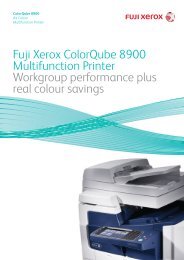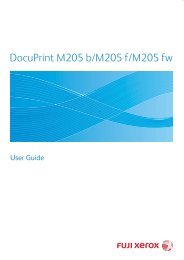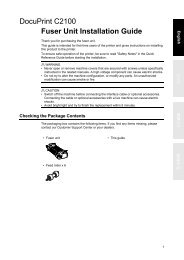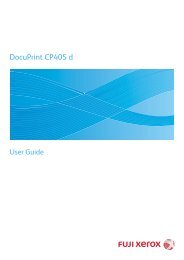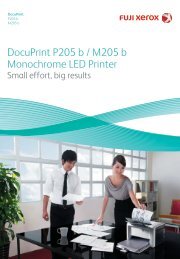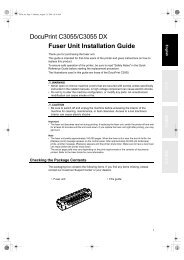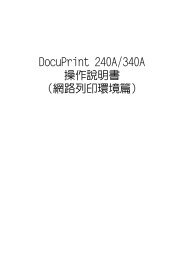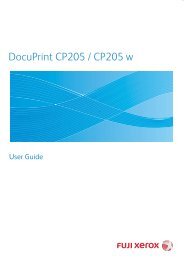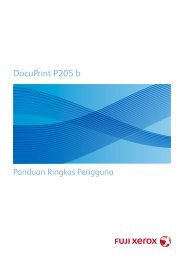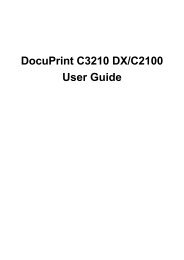Download - Xerox Support and Drivers
Download - Xerox Support and Drivers
Download - Xerox Support and Drivers
You also want an ePaper? Increase the reach of your titles
YUMPU automatically turns print PDFs into web optimized ePapers that Google loves.
Guidelines for selecting <strong>and</strong> storing print mediaGuidelines for special print mediaWhen selecting or loading paper, envelopes, or other print materials,keep these guidelines in mind:• Always use print media that conform with the specifications listed onpage 5.3.• Attempting to print on damp, curled, wrinkled, or torn paper can causepaper jams <strong>and</strong> poor print quality.• For the best print quality, use only high quality copier grade paperspecifically recommended for use in laser printers.• Avoid using the following media types:- Paper with embossed lettering, perforations, or a texture that is toosmooth or too rough- Erasable bond paper- Multi-paged paper- Synthetic paper <strong>and</strong> thermally reactive paper- Carbonless paper <strong>and</strong> Tracing paper.• Use of these types of paper could result in paper jams, chemicalsmells, <strong>and</strong> damage to your printer.• Store print media in its ream wrapper until you are ready to use it.Place cartons on pallets or shelves, not on the floor. Do not placeheavy objects on top of the paper, whether it is packaged orunpackaged. Keep it away from moisture or other conditions that cancause it to wrinkle or curl.• Store unused print media at temperatures between 15 o C <strong>and</strong> 30 o C (59 o F to86 o F). The relative humidity should be between 10% <strong>and</strong> 70%.• Store unused print media in a moisture-proof wrap, such as a plasticcontainer or bag, to prevent dust <strong>and</strong> moisture from contaminatingyour paper.• Load special media types one sheet at a time through the multipurposetray to avoid paper jams.• To prevent print media, such as transparencies <strong>and</strong> label sheets, fromsticking together, remove them as they print out.Media typeEnvelopesGuidelines• Successful printing on envelopes depends uponthe quality of the envelopes. When selectingenvelopes, consider the following factors:- Weight: The weight of the envelope papershould not exceed 90 g/m 2 (24 lb) or jammingmay occur.- Construction: Prior to printing, envelopesshould lie flat with less than 6 mm(0.25 inches) curl, <strong>and</strong> should not contain air.- Condition: Envelopes should not be wrinkled,nicked, or otherwise damaged.- Temperature: You should use envelopes thatare compatible with the heat <strong>and</strong> pressure ofthe printer during operation.• Use only well-constructed envelopes with sharp<strong>and</strong> well creased folds.• Do not use stamped envelopes.• Do not use envelopes with clasps, snaps,windows, coated lining, self-adhesive seals, orother synthetic materials.• Do not use damaged or poorly made envelopes.• Be sure the seam at both ends of the envelopeextends all the way to the corner of theenvelope.AcceptableUnacceptable• Envelopes with a peel-off adhesive strip or withmore than one flap that folds over to seal mustuse adhesives compatible with the printer’sfusing temperature of 200° C (392° F) for0.1 second. The extra flaps <strong>and</strong> strips mightcause wrinkling, creasing, or jams, <strong>and</strong> mayeven damage the fuser.• For the best print quality, position margins nocloser than 15 mm (0.6 inches) from the edgesof the envelope.• Avoid printing over the area where theenvelope’s seams meet.5.3




